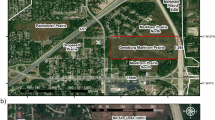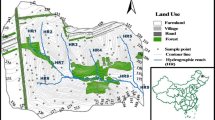Abstract
Purpose
Village landscapes, which integrate small-scale agriculture with housing, forestry and a host of other land use practices, cover more than 2 × 106 km2 across China. Village lands tend to be managed at very fine spatial scales (≤30 m), with managers altering soil fertility and even terrain by terracing, irrigation, fertilizing, and other land use practices. Under these conditions, accumulation of excess phosphorous in soils has become important contributor to eutrophication of surface waters across China’s densely populated village landscapes. The aim of this study was to investigate relationships between fine-scale patterns of agricultural management and soil total phosphorus (STP) within China’s village landscapes.
Materials and methods
First, China’s village landscapes were divided into five environmentally distinct regions across China. Within each region, a single 100 km2 research site was then selected, and 12 500 × 500 m square landscape sample cells were selected for fine-scale mapping. Soils were sampled within fine-scale landscape features using a regionally weighted landscape sampling design.
Results and discussion
STP stock across the 0.9 × 106 km2 area of our five village regions was approximately 0.14 Pg (1 Pg = 1015 g), with STP densities ranging from 0.08 kg m−2 in Tropical Hilly Region to 0.22 kg m−2 in North China Plain and Yangtze Plain, with village landscape STP density varying significantly with precipitation and temperature. Outside the Tropical Hilly Region, STP densities also varied significantly with land form, use, and cover. As expected, the highest STP densities were found in agricultural lands and in areas near buildings, while the lowest were in nonproductive lands and forestry lands. As a combined result of these high STP densities and the predominance of agricultural land use, most village STP stock was found in agricultural lands. A surprisingly large portion of village STP stock was associated with built structures and disturbed lands surrounding them (15.0% in North China Plain, 19.3% in Yangtze Plain, 5.9% in Sichuan Hilly Region, 7.8% in Subtropical Hilly Region, 2.7% in Tropical Hilly Region), which had a significant relationship with population density.
Conclusions
Our results demonstrated that local patterns of land management and human residence were associated with substantial differences in STP both within and across China’s village landscapes which have increased their potential contribution to P pollution. With the rapid change in land use/land cover in China’s densely populated landscapes, such information is essential for rational planning of future management to reach agricultural sustainability.

Similar content being viewed by others
References
Aerts R, Chapin FS III (2000) The mineral nutrition of wild plants revisited: a re-evaluation of processes and patterns. Adv Ecol Res 30:1–67
Allen JL, Mallarino AP, Klatt JG, Camara M (2006) Soil and surface runoff phosphorus relationships for five typical USA midwest soils. J Environ Qual 35(2):599–611
Batjes NH, Dijkshoorn JA (1999) Carbon and nitrogen stocks in the soils of the Amazon Region. Geoderma 89:273–286
Batjes NH, Sombroek SL (1997) Possibilities for carbon sequestration in tropical and subtropical soils. Global Change Biol 3:161–173
Bowman JD, Reeder JD, Lober RW (1990) Changes in soil properties in a central plains rangeland soil after 3, 20 and 60 years of cultivation. Soil Sci 150:851–857
Burgess RL, Sharper DM (1981) Forest island dynamics in man-dominated landscape. Springer, New York
China Agricultural University (1998) Agricultural chemistry. Agricultural Press, Beijing, pp 115–123 in Chinese
Ellis EC (2004) Long-term ecological changes in the densely populated rural landscapes of China. In: DeFries RS, Asner GP, Houghton RA (eds) Ecosystems and land use change. American Geophysical Union, Washington, DC, pp 303–320
Ellis EC, Li RG, Yang LZ, Cheng X (2000) Long-term change in village-scale ecosystems in China using landscape and statistical methods. Ecol Appl 10:1057–1073
Ellis EC, Wang H, Xiao HS, Peng K, Liu XP, Li SC, Ouyang H, Cheng X, Yang LZ (2006) Measuring long-term ecological changes in densely populated landscapes using current and historical high resolution imagery. Remote Sens Environ 100:457–473
Forman RTT, Gordorn M (1986) Landscape ecology. Wiley, New York
Franklin DH, Cabrera ML, West LT, Calvert VH, Rema JA (2007) Aerating grasslands: effects on runoff and phosphorus losses from applied broiler litter. J Environ Qual 36(1):208–215
Grerup UF, Brink DJT, Brunet J (2006) Land use effects on soil N, P, C and pH persist over 40–80 years of forest growth on agricultural soils. Forest Ecol Manag 225:74–81
Holmes KW, Kyriakidis PC, Chadwick OA, Soares JV, Roberts DA (2005) Multi-scale variability in tropical soil nutrients following land-cover change. Biogeochem 74:173–203
Jiang Y, Zhang YG, Liang WJ, Men FX, Liu YJ (2005) Effects of land use on the profile distribution of phosphorus in Aquic Brown soil. J Agro-Enviro Sci 24(3):512–516 in Chinese
Jiao JG, Wu JX, Yang LZ, Li HX, Ellis EC (2006) Effects of land use on soil total nitrogen and phosphorus in different densely populated village landscapes. J Soil Water Conserv 20(3):97–101 in Chinese
Lardy LC, Brossard M, Assad MLL, Laurent JY (2002) Carbon and phosphorus stocks of clayey Ferralsols in Cerrado native and agroecosystems, Brazil. Agr Ecosyst Environ 92:147–158
Litaor MI, Seastedt TR, Walker MD, Carbone M, Townsend A (2005) The biogeochemistry of phosphorus across an alpine topographic/snow gradient. Geoderma 124:49–61
Lu P, Peng PQ, Song BL, Tang GY, Zou Y, Huang DY, Xiao HA, Su YR (2005) Geostatistical and GIS analyses on soil total P in the typical area of Dongting lake plain. Scientia Agricultura Sinica 38(6):1204–1212 in Chinese
Neufeldt H, Silva JED, Ayarza MA, Zech W (2000) Land-use effects on phosphorus fractions in Cerrado oxisols. Biol Fertil Soils 31:30–37
Olsen SR, Sommers LE (1982) Phosphorus. In: Page AL, Miller RH, Keeney DR (eds) Methods of soil analysis part 2. Chemical and microbiological properties. American Society of Agronomy: Soil Science Society of America, Madison, Wisconsin, pp 406–407
Onthong J, Osaki M, Nilnond C, Tadano T (1999) Phosphorus status of some highly weathered soils in peninsular Thailand and availability in relation to citrate and oxalate application. Soil Sci Plant Nutr 45(3):627–637
Saikh H, Varadachari C, Ghosh K (1998) Changes in carbon, nitrogen and phosphorus levels due to deforestation and cultivation: a case study in Simlipal National Park, India. Plant Soil 198:137–145
Sharpley AN, Rekolainen S (1997) Phosphorus in agriculture and its environmental implications. In: Tunney H, Carton OT, Brookes PC, Johnston AE (eds) Phosphorus loss from soil to water. C.A.B. International, Wallingford, pp 1–54
Shen SM, Yu WT, Zhang L, Lian HZ (1993) Internal and external nutrient cycling of poplar tree II. Transferring and cycling of nutrients in and out of the tree before and after leaf fallen. Chinese J Appl Ecol 4(1):27–31 in Chinese
Smil V (2000) P in the environment: natural flows and human interferences. Annu Rev Energy Environ 25:53–88
Tang JD, Ye XY, Rao GL, Lin BS (2003) Effect of human activities on quality of cultivated land in Guangdong province. Soil 1:8–12 (in Chinese)
Vadas PA, Gburek WJ, Sharpley AN, Kleinman PJA, Moore PA, Cabrera ML, Harmel RD (2007) A model for phosphorus transformation and runoff loss for surface-applied manures. J Environ Qual 36(1):324–332
Verburg PH, Veldkamp A, Fresco LO (1999) Simulation of changes in the spatial pattern of land use in China. Appl Geogr 19(3):211–233
Vitousek PM (1994) Beyond global warming: ecology and global change. Ecology 75:1861–1876
Wang H, Ellis EC (2005) Spatial accuracy of orthorectified IKONOS imagery and historical aerial photographs across five sites in China. Int J Remote Sens 26:1893–1911
Wollast R (1993) Interactions of C, N, P and S biogeochemical cycles global change. Springer, Berlin
Xiao PF, Zhang SR, Huang LQ, Gan WZ, Wu DY (2005) Temporal–spatial variability of soil available phosphorus in Chengdu plain. J Soil Water Conserv 19(4):89–93 in Chinese
Zhang Y, Zhang H, Peng BZ, Yang H (2003) Soil erosion and nutrient loss of various land use patterns. Bull Soil Water Conserv 23(1):23–27 in Chinese
Zhang C, Tian HQ, Liu JY, Wang SQ, Liu ML, Pan SF, Shi XZ (2005) Pools and distributions of soil phosphorus in China. Glob Biogeochem cycles 19:GB1020. doi:10.1029/2004GB002296
Zhou ZZ (2000) Landscape changes in a rural area in China. Landscape Urban Plan 47:33–38
Acknowledgments
Funding support came from the US National Science Foundation (DEB-0075617) awarded to Erle C. Ellis in 2000. Work in China was conducted in collaboration with Prof. Lin Zhang Yang of the Institute of Soil Science, Chinese Academy of Sciences (CAS), Nanjing, China, Prof. Hua Ouyang of the Institute of Geographic Sciences and Natural Resources Research, CAS, Beijing, China and Prof. Xu Cheng of China Agricultural University, Beijing, China. We are grateful to our local collaborators for field assistance and anonymous reviewers for helpful comments on the manuscript. Any opinions, findings, conclusions, or recommendations expressed in this material are those of the authors and do not necessarily reflect the views of the National Science Foundation.
Author information
Authors and Affiliations
Corresponding author
Additional information
Responsible editor: Gilbert Sigua
Rights and permissions
About this article
Cite this article
Jiao, J., Ellis, E.C., Yesilonis, I. et al. Distributions of soil phosphorus in China’s densely populated village landscapes. J Soils Sediments 10, 461–472 (2010). https://doi.org/10.1007/s11368-009-0135-4
Received:
Revised:
Accepted:
Published:
Issue Date:
DOI: https://doi.org/10.1007/s11368-009-0135-4




